
概述
该策略是一个基于移动平均线的突破交易策略。策略的主要思想是通过比较当前收盘价与一定周期的移动平均线,来判断市场的趋势,并在突破移动平均线时进行交易。该策略的风险报酬比为1:3,即止损位置为1%,止盈位置为3%。
策略原理
该策略的核心是移动平均线。移动平均线是一条连接一定时间周期内收盘价平均值的曲线,能够smooth out价格的短期波动,反映出股价的中长期趋势。当股价突破移动平均线时,意味着市场趋势可能发生改变。
策略的具体原理如下:
- 计算一定周期(默认为20)的移动平均线。
- 判断当前收盘价是否上穿或下穿移动平均线。
- 如果上穿移动平均线,则开仓做多,止损位置为开仓价的1%,止盈位置为开仓价的3%。
- 如果下穿移动平均线,则开仓做空,止损位置为开仓价的1%,止盈位置为开仓价的3%。
- 如果上穿移动平均线,则开仓做多,止损位置为开仓价的1%,止盈位置为开仓价的3%。
- 如果已经开仓,则判断是否触及止损或止盈价位:
- 如果多头仓位触及止损或止盈价位,则平仓。
- 如果空头仓位触及止损或止盈价位,则平仓。
- 在图表上绘制出移动平均线,以便观察股价与均线的关系。
优势分析
该策略的优势在于:
- 简单易用:该策略只使用了一根移动平均线,逻辑清晰,容易理解和实现。
- 趋势跟踪:移动平均线能够反映股价的中长期趋势,通过突破移动平均线开仓,可以跟踪市场的主要趋势。
- 固定风险报酬:该策略的止损和止盈位置是固定的,风险报酬比为1:3,能够严格控制每笔交易的风险。
- 适用性广:该策略可以应用于不同的市场和品种,如股票、期货、外汇等。
风险分析
尽管该策略有一定的优势,但也存在一些风险:
- 参数优化:该策略的关键参数是移动平均线的周期,不同的周期可能会带来不同的结果。如果参数选择不当,可能会导致策略失效。
- 市场风险:该策略在趋势性市场中表现较好,但在震荡市场中可能会出现较多的false signals,导致频繁交易和资金损失。
- 滑点和交易成本:该策略可能会产生较多的交易信号,频繁交易会增加滑点和交易成本,从而影响策略的整体表现。
为了降低这些风险,可以考虑以下改进措施: 1. 进行参数优化,找到最适合当前市场的参数组合。 2. 加入其他过滤条件,如交易量、波动率等,以减少false signals。 3. 控制交易频率,如增加信号过滤,避免过于频繁的交易。
优化方向
- 多时间周期结合:可以考虑结合不同时间周期的移动平均线,如短期、中期和长期均线,根据它们的排列和交叉情况来产生交易信号。这样可以更全面地判断市场趋势,提高信号的可靠性。
- 动态止损止盈:目前策略的止损止盈位置是固定的,可以考虑根据市场波动情况动态调整止损止盈位置,如使用ATR(Average True Range)等指标来计算动态止损止盈价位。这样可以更好地适应市场变化,提高策略的灵活性。
- 加入其他技术指标:除了移动平均线外,还可以加入其他技术指标,如MACD、RSI等,以多指标共同确认交易信号,提高信号的可靠性。
- 市场环境适应:可以根据不同的市场环境,如趋势市场、震荡市场等,调整策略的参数或规则,以适应不同的市场特点,提高策略的适应性和稳定性。
- 加入仓位管理:目前策略每次交易的仓位是固定的,可以考虑根据市场波动性、账户资金等因素,动态调整每次交易的仓位大小,以更好地控制风险,提高资金利用效率。
通过以上优化措施,可以提高策略的可靠性、适应性和稳定性,更好地适应市场变化,提高策略的整体表现。
总结
该策略是一个简单易用的趋势追踪策略,通过比较收盘价与移动平均线的关系,在价格突破均线时产生交易信号。该策略的优势在于逻辑清晰,适用性广,能够跟踪市场的主要趋势。但同时也存在一些风险,如参数选择、市场风险、交易成本等。为了改进策略,可以考虑多时间周期结合、动态止损止盈、加入其他技术指标、市场环境适应、仓位管理等优化措施。
总的来说,该策略可以作为一个基础性的交易策略,适合初学者学习和使用。但在实际应用中,还需要根据具体的市场情况和自身的风险偏好,对策略进行适当的优化和改进,以提高策略的稳定性和盈利能力。同时,任何策略都有其局限性,不能盲目依赖,应该结合其他方法和工具,如基本面分析、风险管理等,以更全面地把握市场机会,控制交易风险。
策略源码
/*backtest
start: 2024-02-01 00:00:00
end: 2024-02-29 23:59:59
period: 1h
basePeriod: 15m
exchanges: [{"eid":"Futures_Binance","currency":"BTC_USDT"}]
*/
//@version=4
strategy("Nifty Breakout Strategy", overlay=true)
// Define Inputs
breakoutPeriod = input(20, title="Breakout Period")
stopLossPercent = input(1, title="Stop Loss (%)") / 100
takeProfitPercent = input(3, title="Take Profit (%)") / 100
// Calculate Moving Average
smaValue = sma(close, breakoutPeriod)
// Define Breakout Conditions
longCondition = crossover(close, smaValue)
shortCondition = crossunder(close, smaValue)
// Set Stop Loss and Take Profit Levels
longStopLoss = close * (1 - stopLossPercent)
longTakeProfit = close * (3 + takeProfitPercent)
shortStopLoss = close * (1 + stopLossPercent)
shortTakeProfit = close * (3 - takeProfitPercent)
// Execute Long Trade
if (longCondition)
strategy.entry("Long", strategy.long)
strategy.exit("LongExit", "Long", stop=longStopLoss, limit=longTakeProfit)
// Execute Short Trade
if (shortCondition)
strategy.entry("Short", strategy.short)
strategy.exit("ShortExit", "Short", stop=shortStopLoss, limit=shortTakeProfit)
// Plot Moving Average for Visualization
plot(smaValue, color=color.blue)